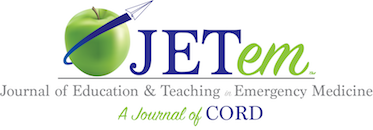Myopericarditis and Pulmonary Edema
ABSTRACT:
Audience:
This oral board case is intended to be used with senior emergency medicine residents.
Introduction:
Pericarditis and myocarditis are two disease entities that refer to inflammation of the pericardium and the myocardium.1 In clinical practice, when they occur together the term myopericarditis is used.1 Myopericarditis is a disease etiology that is uncommonly encountered in the emergency department (ED). Pericarditis accounts for 0.2% of all cardiovascular admissions and myopericarditis is even more rare with an unknown exact incidence.2 These pathologies can present with a wide spectrum of complaints varying from a simple case of chest pain to more severe hypotensive pulmonary edema, cardiogenic shock, and cardiac arrest.2 Since these pathologies primarily affect the younger patient population,2 they require careful consideration by the Emergency Physician (EP) as well as a systematic comprehensive approach to managing these critically ill patients. The majority of cases are of idiopathic origin; however, the causes of pericarditis are divided into infectious and noninfectious, with infectious cases primarily resulting from viral infections.3 Causes of myocarditis, on the other hand, can be divided into infectious, immune-mediated, and toxic.2 Although myopericarditis is a rare disease, its high acuity makes it an important case to enhance the educational experience of emergency medicine residents and their associated faculty.
Educational Objectives:
At the end of this oral board session, learners will be able to: 1) Demonstrate the ability to evaluate and treat a somnolent and hypoxic patient, 2) Identify a critical airway situation and manage it with a holistic approach, 3) Interpret the history, physical examination, ECG, and chest x-ray findings and discuss the list of differential diagnoses, 4) Identify a state of cardiogenic shock induced by myopericarditis and treat it appropriately, 5) Assess the presence of pericardial effusion and cardiac tamponade utilizing bedside echocardiography.
Educational Methods:
This is an oral board case and is implemented in a face-to-face setup or virtually on multiple available technological modalities.
Research Methods:
This oral mock code was developed for senior emergency medicine residents to prepare for their oral board exams. Each session lasted approximately 25 minutes, with 10 minutes for the case and 15 minutes for debriefing. The case, initially designed as myopericarditis-induced pulmonary edema progressing to shock and rhabdomyolysis, was later simplified because it was challenging for residents to identify all the elements within the time allotted. Positive feedback indicated the case was educational and beneficial, though extending the case duration to 15 minutes was recommended. Performance was assessed using the Accreditation Council for Graduate Medical Education (ACGME) core competencies with a scoring scale of 1 – 8, with 1 – 4 being unacceptable performance and 5 – 8 being acceptable. Efficacy was determined by case completion and participation in structured debriefing. Immediate verbal feedback and a post-session Likert-scale survey further supported its educational value. The case is also adaptable for simulation-based group learning.
Results:
Five senior residents (three PGY4 and two PGY3) completed the oral case, achieving an average score of 6.01/8, with only one resident completing all critical actions. The most commonly missed intervention was administering aspirin or ibuprofen, and none considered advanced circulatory support despite persistent hypotension. The case was rated highly for educational value (5/5), all of them reported that it increased their medical knowledge, and it was similar to real-life scenarios. Some also noted it increased their confidence level and the case difficulty was rated as moderate (3/5) by the majority of the residents.
Discussion:
The educational content of this case is effective because it is multifaceted and requires consideration of multiple factors during both the approach and management. These elements produce an excellent case for discussion, practice, and examination. Points learned while implementing the case were that, 1) its degree of difficulty is more suitable for senior rather than junior learners because it involves a critically ill patient with multiple simultaneous issues to be managed, 2) it requires a well-rounded and systematic approach to achieve all critical actions, and 3) the appropriate prompts should be utilized to cover all aspects in the allotted 15 minutes for the case.
Topics:
Myopericarditis, pulmonary edema, cardiogenic shock, sepsis, septic shock.
